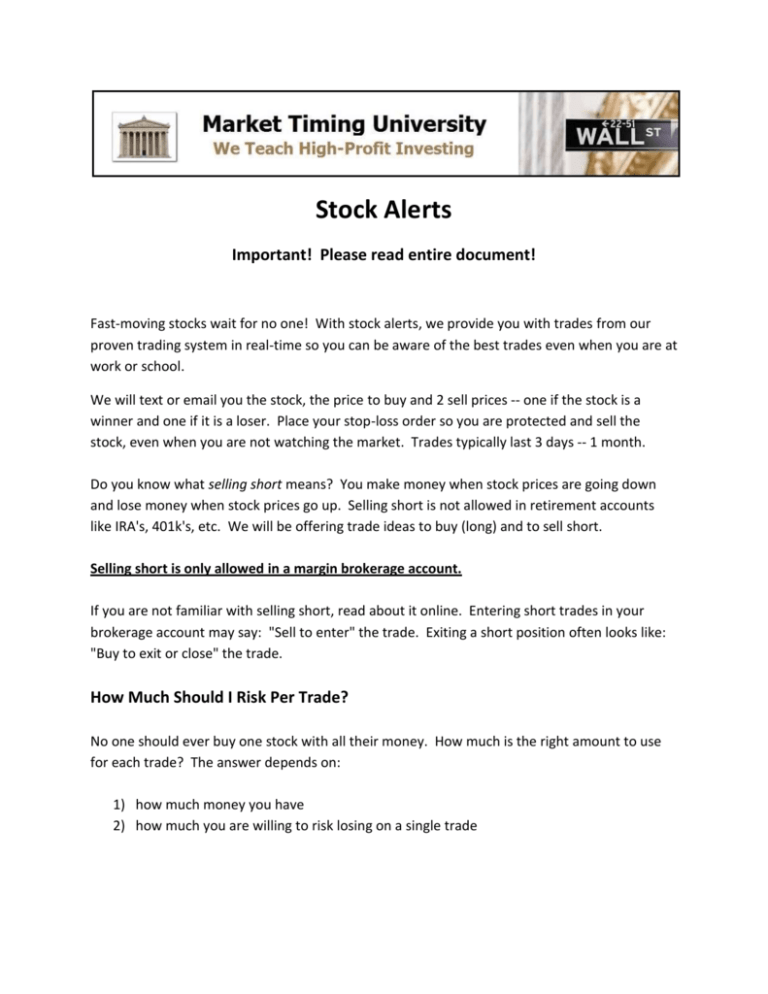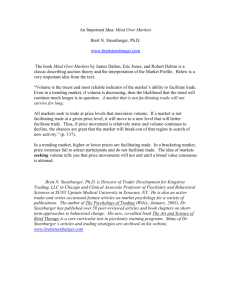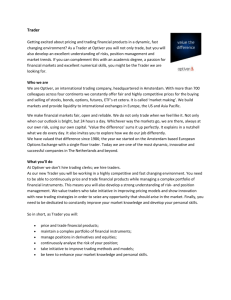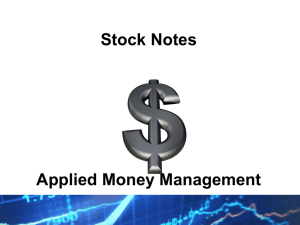Stock-Alerts-Risk-Guidelines
advertisement

Stock Alerts Important! Please read entire document! Fast-moving stocks wait for no one! With stock alerts, we provide you with trades from our proven trading system in real-time so you can be aware of the best trades even when you are at work or school. We will text or email you the stock, the price to buy and 2 sell prices -- one if the stock is a winner and one if it is a loser. Place your stop-loss order so you are protected and sell the stock, even when you are not watching the market. Trades typically last 3 days -- 1 month. Do you know what selling short means? You make money when stock prices are going down and lose money when stock prices go up. Selling short is not allowed in retirement accounts like IRA's, 401k's, etc. We will be offering trade ideas to buy (long) and to sell short. Selling short is only allowed in a margin brokerage account. If you are not familiar with selling short, read about it online. Entering short trades in your brokerage account may say: "Sell to enter" the trade. Exiting a short position often looks like: "Buy to exit or close" the trade. How Much Should I Risk Per Trade? No one should ever buy one stock with all their money. How much is the right amount to use for each trade? The answer depends on: 1) how much money you have 2) how much you are willing to risk losing on a single trade Principle #1 -- The more money you have, the more you can afford to risk losing The more money you have, the more you can afford to risk without it hurting you too much. Someone with $5 million can afford to lose $10,000 but someone whose entire savings is $20,000 can't afford to lose that much. Risk is the potential loss from the trade; risk is not how much money it takes to buy the stock. For example, let's say that Trader #1 has $100,000 and Trader #2 has $20,000. You receive a trade alert based on news for XYZ stock: MTU Trade Alert! Buy XYZ stock (as soon as possible) at $20 or less Sell (Stop Loss) at $18 or sell at a profit in one month. Trader #1 buys 500 shares at $20/share for $10,000. If the stock drops to $18, the trader will sell 500 shares at a $2/share loss or $1,000. This is reasonable risk for someone with $100,000. Trader #2 buys 100 shares at $20/share for $2,000. If the stock drops to $18, the trader will sell 100 shares at a $2/share loss or $200. This is reasonable risk for someone with $20,000. The potential loss is known before the trade is entered based on how many shares were purchased and how far it is to the stop loss price. If you are comfortable risking more, you can purchase more shares. If you want to risk losing a little less, buy fewer shares. We recommend trading without money or with small amounts until you are comfortable with how the system works and how much you are willing to risk. Principal #2 -- Gaps What is a gap? Most of the time, stocks open trading each day about the same price it closed the previous trading day. However, sometimes news comes out after trading hours that can have a large effect on the stock price. The stock may then open trading much higher or lower than the previous day's closing price. This is called a "gap" because there is a gap on the stock chart from one day to the next. You always want to use a Stop Loss order. Stop Loss orders will sell your stock if it hits your pre-determined limit, even if you aren't watching. The problem is that if a stock gaps in price from one day to the next, you could lose more than you originally calculated. In the previous example, the stock could gap from $19 to $13, leaving each trader with a $6/share loss. Trader #1 would lose $3,000 instead of $1,000 and Trader #2 would lose $600 instead of $200. For this reason, you should not get too aggressive with this or any other trading strategy -unforeseen events do happen. Follow these guidelines and reap the rewards of safe, profitable trading. Sincerely, Gregg Killpack Gregg Killpack President Market Timing University, LLC. Salt Lake City, Utah tradergreggk@gmail.com Disclaimer Stock Alerts is for informational and educational purposes only. There are no warranties or representations that information provided herein is accurate or in any way will lead to successful investment strategies. Nothing in this material should be construed as an offer to buy or sell securities or an endorsement or recommendation to buy or sell securities. Gregg Killpack, Market Timing University and their affiliates and employees are not licensed brokers, broker-dealers, market makers, investment bankers or investment advisors. Nothing herein should be construed as investment advice. There is substantial risk for loss when trading or investing. A stock's actual results could differ materially from forecasts due to certain inherent market risks. Past performance is not a guarantee of future results. Please consult a licensed broker, investment advisor or financial planner before trading or investing. Gregg Killpack, Market Timing University and/or their affiliates, officers, directors, or employees may trade in the securities and/or markets discussed herein and may profit in the event shares of the companies and/or markets discussed in the course rise or fall in value. This is distributed with the understanding that neither the publisher or author are engaged in rendering legal, accounting, investment or other professional services. Trading and investing involves substantial risk. Financial loss, even above the amount invested, is possible and common. Hypothetical or simulated performance results have certain inherent limitations. Unlike an actual performance record, simulated results do not represent actual trading or investing. Also, since the trades or investments have not been executed, the results may have under- or overcompensated for the impact, if any, of certain market factors, such as lack of liquidity. Simulated trading or investing programs in general are also subject to the fact that they are designed with the benefit of hindsight. No representation is being made that any account will or is likely to achieve profits or losses similar to those shown.





